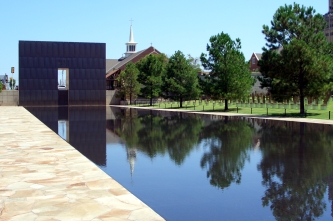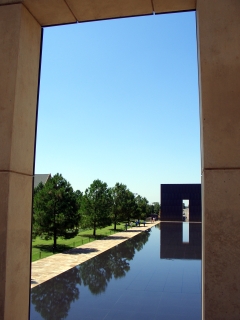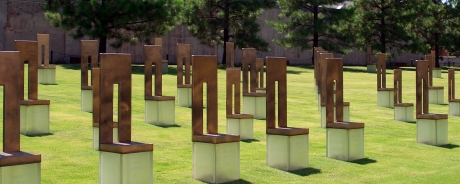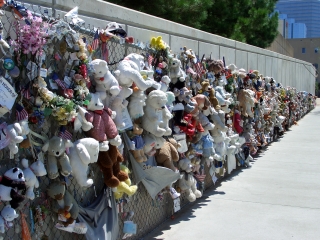NPS Website; Local Website
WHAT IS IT?
Outdoor Memorial and privately run interactive museum dedicated to the memory of those lost in the 1995 terrorist bombing of Oklahoma City’s Alfred P. Murrah Federal Building.
 BEAUTY (6/10)
BEAUTY (6/10)The Outdoor Memorial is located on the same location as the former Murrah Federal Building. In the building’s place are two towering gates, they look like stylized Arc de Triomphe’s. You enter through the East gate, marked 9:01, the time the bomb detonated and see a shallow reflecting pool. To you left is a field of 168 empty golden chairs, marking the lives lost in the tragedy. To you right is the Survivor Tree, a 90-year old American elm that miraculously stayed standing while the blast occurred nearby.
You exit through the West gate, marked 9:03, the moment, the Site literature says, we were changed forever. Outside the West gates is a chained link fence littered with hanging stuffed animals and personal items that remember the dead. The Museum sits inside the neighboring Journal Record Building. Its southern wall, which was damaged by the blast, remains scarred from the detonation and lined with graffiti written by rescue workers.
HISTORICAL INTEREST (4/10)
At the time, the April 19, 1995 bombing that took 168 lives was the deadliest terrorist attack ever on American soil. Of course, the events of September 11, 2001 took away Oklahoma City’s horrible distinction. Unlike 9/11, Oklahoma City made no impact on a political, cultural or historical scale. A global War was not needed to bring justice to the OKC bomber, Timothy McVeigh. The lives of the victims changed dramatically as did the locality of Oklahoma City but the OKC bombing did not become the focus of American thought and a generational touchstone.
CROWDS (6/10)
Who knows how many people were at the Memorial and Museum. We did not pick our heads out of countless displays, exhibits and computers long enough to see anyone.
 EASE OF USE/ACCESS (4/5)
EASE OF USE/ACCESS (4/5)The Memorial is located near downtown Oklahoma City between NW 4th and 6th Streets and Robinson and Harvey Avenues. The Memorial’s design suggests entrance from the east, through the 9:01 gate located at 5th and Robinson.
If you are coming from the west, take the Walker Avenue Exit of Interstate 40, travel north on Walker for ten short blocks until you reach 4th. Turn right. Three blocks later, you are there.
If you are traveling from the north, south or east, take 6th Street/Harrison Ave./Downtown Exit of Interstate 235. Go west for three blocks along 6th Ave, turn left on Robinson and you are there.
There is no on-site parking. Day-use parking lots surround the Memorial and cost $5. Metered street parking is available but carries a 2-hour limit, not enough time to experience the engrossing Museum.
CONCESSIONS/BOOKSTORE (5/5)
The gifts and keepsakes on sale at the Memorial Store are classy, tasteful and understated. They utilize the simple, but moving Survivor Tree logo, muted colors and comfortable designs. Dozens of books about the bombing line the walls. Stuffed firefighter and rescue dogs are sold for the kids. The Store’s online bookstore sells only a small portion of the merchandise.
COSTS (1/5)
The privately funded Oklahoma City National Memorial Trust fully endows and operates the Memorial. The Site is a member of the National Park Service in name only. An NPS Ranger walks the outside portion of the Memorial. The OKC NMEM Trust pays the Site’s Rangers, not the Federal Government.
The Museum does not honor any National Parks Passes and costs $7 per person. The Outdoor Memorial is free. We have heard that the NPS is in the process of distancing themselves from the OKC NMEM and will remove the Site’s National Park Unit distinction. That would be a good move. The Museum is a private entity, the National Park Service did not design its exhibits, the government gives it no funding and it is doing well enough on its own.
 RANGER/GUIDE TO TOURIST RATIO (1/5)
RANGER/GUIDE TO TOURIST RATIO (1/5)The Museum is overwhelmingly interactive; the number of touch screen monitors could wear the fingerprints off one’s skin. We still would have enjoyed someone to answer questions, an indoor Ranger or maybe a hired docent. The Site relegates its NPS Ranger to outdoor duty. The Ranger spends the day pacing the reflecting pool area and must regularly sweat off a few pounds in the sweltering OKC afternoons.
TOURS/CLASSES (8/10)
The day before our visit, an OKC resident told us that he had just made his first trip, at a friend’s behest, into the Museum. He was not keen on remembering the day’s horror and figured he would be there for an hour at most. “I’m walking through the Museum and I look down at my watch,” he recalled “and I had been there for three hours. I just got caught up.”
We had a similar time-bending experience. The Museum sucks you in like a true-life cable-TV documentary. The story told is triumph over tragedy. Hundreds of interviews play on continuous loops on televisions posted throughout the Museum. The stories are all positive reinforcements of human nature’s good side.
Victims’ stories are told via computer interviews with their families, personal mementos and pictures. When you read and hear the victims’ positive life stories you initially are saddened by their families’ loss but eventually are strengthened in the understanding that they are just a standard representation of humanity and that people are good. We were touched by the documentary about OKC victims traveling to New York shortly after 9/11 to help with those who lost loved ones.
Much of the conclusions the OKC Museum makes concerning terrorism and violence are contradictory and superficial; it is much easier to ignore the broad picture here and focus on the heroic efforts and good intentions of the people involved. We also found the Museum’s self-comparisons, both in design and gravity, to the victims’ museums in Auschwitz and Hiroshima to be foolish at best.
FUN (6/10)
Prior to its design, the Museum planners asked victims’ families and Oklahoma City residents how they wanted to feel at the Memorial. The winning emotions became the Site’s theme: comfort, strength, peace, hope and serenity. We all want to feel these emotions and somehow a Museum about a terrorist bombing achieves that collective aura.
It succeeds by virtually ignoring the perpetrator. When the Museum mentions Timothy McVeigh and his accomplice, the display is in a discrete corner or written in small print on a large panel. The bombing comes to feel like a natural disaster. The Site determines McVeigh’s motivations, reasoning, planning and story to be irrelevant and does not address them.
 Instead, we learn about the victims, their families, Oklahoma City, the firefighters, the EMT’s, the newscasters and everyone who helped. Before visiting the Memorial, we had already gathered a strong liking for Oklahoma City, its people, its restaurants and its museums.
Instead, we learn about the victims, their families, Oklahoma City, the firefighters, the EMT’s, the newscasters and everyone who helped. Before visiting the Memorial, we had already gathered a strong liking for Oklahoma City, its people, its restaurants and its museums.WOULD WE RECOMMEND? (6/10)
A trip to Oklahoma City is not complete without a trip to the Outdoor Memorial if not the Museum. The Site defines the town and its people.
TOTAL 47/80
www.usa-c2c.com
© 2005